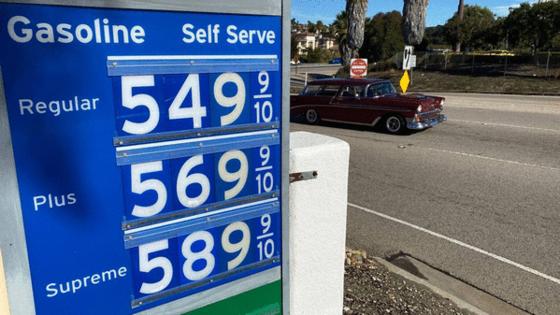This California law was supposed to stop gasoline price gouging. Has it?
Published in News & Features
Two years after California’s Democratic leaders declared victory over big oil with a law aiming to crack down on industry profits, the state has been unable to prove companies engage in price gouging when the cost of gasoline spikes in California.
Since late 2022, Gov. Gavin Newsom has accused the oil industry of ripping off California drivers, pointing to an extreme price spike in the state compared to the rest of the country – while companies reported record profits.
“Open your books and prove that you’re not price gouging. Otherwise, you – big oil – will pay the price, not consumers,” then-Sen. Nancy Skinner said after Newsom signed the bill she authored that created an industry watchdog division and gave the California Energy Commission authority to cap oil company profits and return funds to taxpayers.
But the state hasn’t leveled any penalties on oil refining companies since the law passed and has even stopped posting the data it required.
Still, state leaders call the law a success and say it has flattened price spikes and lowered the average cost of gas since it took effect. They also laud the transparency tools for helping shape additional regulations for the market.
Where’s the data from the California Energy Commission?
Skinner’s bill, SBX1-2, along with a previous 2022 law, require refineries to submit monthly reports about their sales, profit margins and other information. Within 45 days, the CEC is required to publish the information, which breaks down the average per-barrel profit earned each month by three different refiners, which are kept anonymous to protect company information.
But the CEC has not updated figures showing net margins – or total profit earned or lost when a refinery includes operational costs – since April 2024. It has posted figures showing refiners’ average gross margins, which are the wholesale price of gasoline minus the price of crude oil.
Notes on the CEC web page indicate the data provided by the refining companies isn’t trustworthy.
“CEC has not assessed whether refiners have properly deducted various costs from their self-reported margins,” one note reads. It goes on to say the “data reported by multiple refiners has demonstrated extreme variability that is likely not accurate nor reliable.”
CEC spokesperson Sandy Louey said the agency adopted new reporting requirements in May 2024 and is working with refiners to ensure the data is accurate. The regulatory body intends “to publish the updated information as promptly as possible.”
She also noted the agency still has authority to impose a “potential maximum gross gasoline refining margin and a penalty for refiners that exceed it,” along with other regulations.
Catherine Reheis-Boyd, president of the Western States Petroleum Association, alleged there’s a different reason the public reports stopped: “It’s not supporting the narrative.”
“We did a bunch of data reporting because of this assertion that oil companies were gouging the public, and so, my God, we’ve got to collect this data to prove it,” she said. “Well, the reason that they don’t publish the data anymore is because it doesn’t prove it.”
Several months of available data show that two refiners had five consecutive months of negative margins, with losses ranging between nine and 44 cents per gallon between October 2023 and February 2024.
Reheis-Boyd said the state bears blame for high gas prices, noting state and local taxes, along with costs for environmental programs add up to roughly $1.30 per gallon.
“If we’re going to talk about the price of the pump, let’s talk about what goes into it because $1.30 of it ain’t us,” she said.
Severin Borenstein, a UC Berkeley energy economist, agreed with CEC’s assessment and called the initial data provided by refining companies “pretty much unusable.”
“It was clear that the companies were not all reporting in the same way, they were counting different things in different categories, and they were posting numbers that were just completely implausible,” he said in an interview this week.
Borenstein had hoped the data would provide clarity for his research into the state’s “mystery gasoline surcharge” but it still remains an enigma. He also believes oil refiners aren’t the only industry groups responsible for high prices at the pump.
“I have continued to beat the drum that we need more investigation of the downstream part of the market,” or gasoline distribution, marketing and retail, he said. “The Legislature and governor have continued to propose policies for the upstream part of the market – the refining part – which isn’t where most of the problem is.”
Despite the lack of recent public data, Newsom and the CEC lauded the law and credit it for lowering average gasoline costs in 2023 and 2024.
“In the two years since the governor signed California’s gas price gouging law, the state has avoided severe gasoline price spikes like the historic 2022 spike, saving Californians billions of dollars at the pump,” Newsom spokesperson Daniel Villaseñor said.
“Using the critical new data provided by SB X1-2, (the Division of Petroleum Market Oversight), in collaboration with CEC staff, was able to positively identify the root causes of the fall 2022 and fall 2023 retail gasoline price spikes: inadequate resupply, low inventories, and a volatile spot market,” Louey said in an email.
What’s next in the battle over gas prices?
California gas prices are typically higher than around the rest of the country due to a combination of high taxes and stricter environmental standards. The state also relies on its own in-state refiners for gasoline so when there are supply disruptions like unplanned maintenance, they affect prices more acutely.
California officials’ crusade against oil companies began in 2022. Nationwide, gas prices rose after Russia invaded Ukraine and the United States stopped importing Russian crude. But when prices fell later that year for the rest of the country, they spiked again in California. That led Newsom to accuse oil companies of price gouging in California.
For their part, those companies largely blamed simultaneous maintenance issues at several refineries in the state.
Energy regulators have said the transparency measures from SBX1-2 revealed another problem: when refineries go down, the dip in supply causes prices to spike.
Knowing that, Newsom called another special session last fall and the Legislature passed a law giving the CEC the authority to impose rules to ensure refiners can still provide product during an outage.
The agency is currently working on a rule that would require refineries to have a “resupply plan” in those cases to ensure the market isn’t jarred by unplanned maintenance. It is planned for a vote this spring.
“We have more tools on the way, including requiring oil refineries to maintain adequate supply to protect the state from supply-driven price spikes,” Villaseñor said.
____
©2025 The Sacramento Bee. Visit at sacbee.com. Distributed by Tribune Content Agency, LLC.







Comments